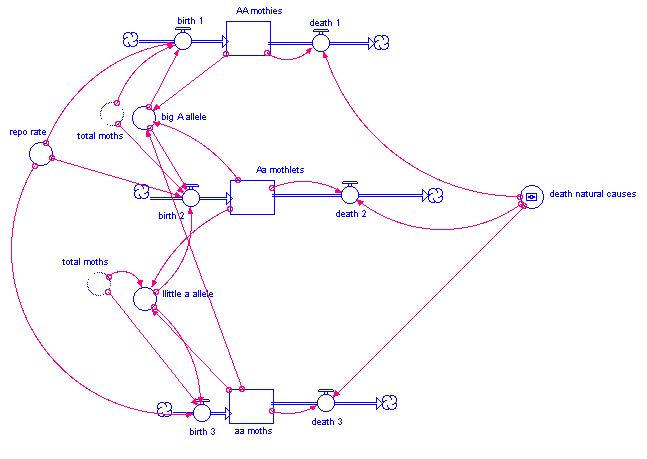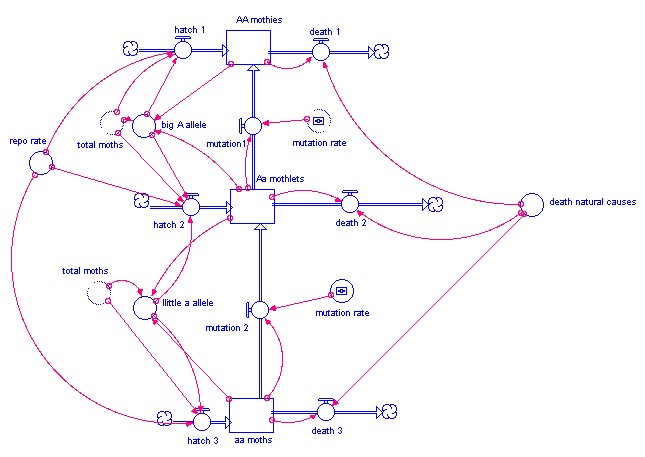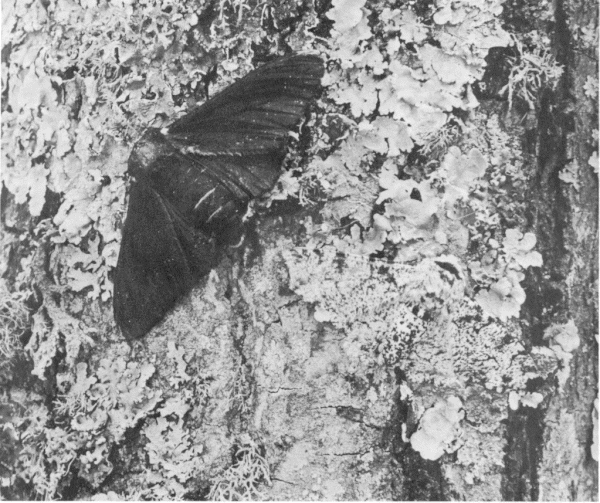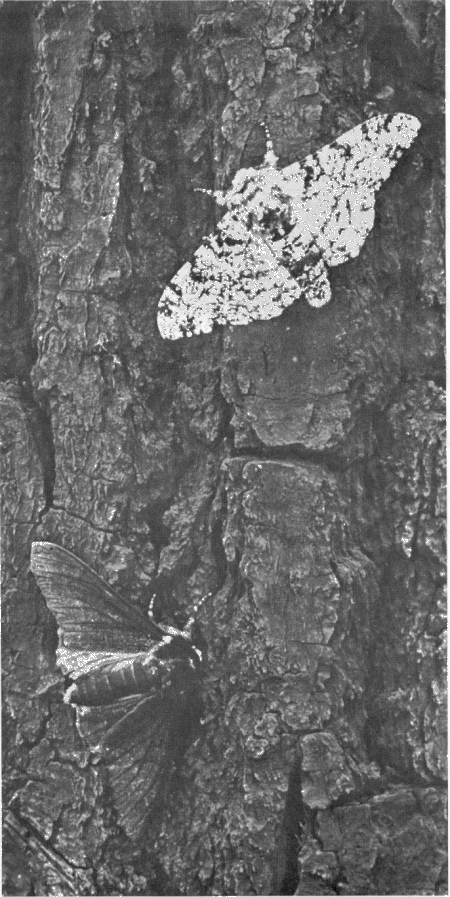|
a collaboration of the
Shodor Education Foundation, Inc.
, Eastern North Carolina School for the Deaf,
Barton College
, the
National Technical Institute for the Deaf
, and
Interpreters, Inc.
|
|
|
Home
|
For Interpreters!
|
Search
|
Peppered Moths
Mutation
 ASL | In the 1920's Heslop Harrison thought that pollution was causing mutations in the moths making them dark. Harrison decided to test his idea by conducting experiments with moths. He claimed that feeding polluted leaves to larvae darkened the moths. He didn't use peppered moths. He used similar moths that like peppered moths appear as light and dark colored moths. When the pupae (caterpillars) were fed leaves coated with coal soot the wings of the adults were darker. |
 ASL | Harrison concluded that the darker moths were a result of pollution induced mutations in the moths, not natural selection. |
 ASL | Other scientists tried to replicate Harrison's experiments using peppered moths. They didn't get the same results. In their experiments the moths didn't get darker. A few scientists have breed peppered moths for their experiments. They cross light and dark moths. The next generation fit the same pattern Mendel found with his peas. One gene controls whether the moth is light or dark. The dark form "A" is dominant and the light form "a" is recessive. |
 ASL | Is it possible that both Harrison and the other scientists honestly reported their experiments? |
 ASL | How can you explain the different results? |
 ASL | A few gray peppered moths have been reported. These rare gray moths are almost never seen in the industrial areas. Scientists don't consider these gray moths relevant. |
 ASL | How would you explain the gray moths? |
 ASL | Do you agree that the gray moths aren't relevant? Explain. |
 ASL | Scientists rejected Harrison's idea that pollution caused frequent mutations turning the peppered moths dark. As scientist you need to ask, "What part or part(s) of Harrison's idea were wrong?" Scientists don't want to, "Throw out the baby with the bath water." |
 ASL | Harrison's basic idea was that mutations not natural selection caused the change in peppered moth frequency. A second part of his idea was that eating polluted leaves causes the mutation. A third part of the idea was that if one generation did something to acquire a characteristic they would pass that characteristic on to their descendants. DNA hadn't been discovered yet so the mechanism for mutations wasn't well understood. |
 ASL | Which part(s) of Harrison's idea were shown to be wrong? |
 ASL | Scientists wondered if the mutations were caused by some other factor. Perhaps it was only a coincidence that the moths changed color as the pollution increased. Back in the twentieth century scientists couldn't do DNA analysis of the moths in the English countryside. The DNA analysis that we can do today is limited because almost all of the peppered moths are white again. |
 ASL | You can use a computer model to simulate the change in the population caused by this proposed mutation. You will be using a Stella model. The model follows the 3 genotypes for the peppered moths: AA, Aa, and aa. Each type of moth hatches from eggs, lives for a year and then dies.
|
 ASL | The converter "death natural causes" holds the death rate for the moths. When you run the model you will be able to adjust this rate using a slider bar. |
 ASL | The flows "death1", "death2" and "death3" subtract moths from each of the stocks to simulate the moth's deaths by natural causes. The number of moths subtracted = the number of moths in the stock times the rate in "death natural causes." |
 ASL | The algorithm for the moths that hatch is derived from a mathematical expression developed by the researchers G.H. Hardy and W. Weinberg . Hardy and Weinberg's mathematical expression describe the equilibrium of the genotype frequencies, which occur under random sexual mating. The mathematical expression assumes a large population size, no mutation, no migration, and no natural selection. (p2 + 2pq + q2 = 1) where p2 is the frequency of AA , 2pq is the frequency of Aa, and q2 is the frequency of aa.
|
 ASL | So far the model, like the Hardy Weinberg expression, assumes no mutation. Two flows are added to adjust the moth population by mutation. Flow "mutation1" changes Aa moths to AA moths at the rate set by converter "mutation rate." Flow "mutation2" changes aa moths to Aa moths by the 2 times the "mutation rate." Each aa moth has two a alleles that can mutate.
|
 ASL | Ask you teacher if you have the Stella model. If your school has Stella, open the "mutation1" model. Click the up triangle in the upper left corner to move to the interface page. You will see a graph, a run button and one slider. |
 ASL | On the Stella model you will use the red slider bar to adjust the mutation rate between 0 (no mutations) to .1 (10% of the alleles mutate each year). Click the "Run" button and watch the moth population change. Click and holding different places on the graph will show you the frequencies for different years. |
 ASL | If you don't have the Stella model you can use a Java version of the same model. Use this button to open the Java model. |
 ASL | On the Java model use the mutation_rate slider bar to adjust the mutation rate between 0 (no mutation) to .1 (10% of the alleles mutate each year). Clicking the "Text Output' box shows you the values for each year's frequencies. |
 ASL | Using either model adjust the "mutation rate" slider to the mutation that you think will cause the moths to change to 98% dark in 50 years. Continue adjusting the "mutation rate" and running the model until you have 98% after 50 years. |
 ASL | What mutation rate simulated the observed change in nature? |
 ASL | What percentage of the aa and Aa moths are mutating each year? |
 ASL | Scientists have found that mutations occur less than .005% of the time. |
 ASL | In the 1950s England and the United States enacted legislation to reduce air pollution. In the last 50 years the frequency of dark and white peppered moths in both England and the U.S. have returned to almost all white peppered moths. |
 ASL | In the 1950s B. Kettlewell did a series of experiments to see if Tutt's idea of natural selection was reasonable. First Kettlewell wanted to see and document how well peppered moths are camouflaged on polluted and non-polluted trees. Kettlewell asked a nature photographer to help him take pictures of peppered moths on different trees. Peppered moths are so rare that scientists often only see one or two peppered moths per year in their natural hiding places. The nature photographer took dark and light colored peppered moths and placed them side-by-side on tree trunks to get his photographs. |
 ASL | Can you find both the dark and light peppered moth in these photographs?
|
 ASL | Can you conclude that the peppered moths have effective camouflage? |
 ASL | Some of the scientists of the time criticized Tutt's idea of natural selection by bird predation. One criticism was that no one had ever seen a bird eat a peppered moth. For that matter very few peppered moths are seen in the wild. Scientists think that there are fewer than 100 peppered moths per square kilometer. The best way to find peppered moths is at night, using a light trap. |
 ASL | Kettlewell wanted to see if birds would eat peppered moths. He collected some moths and took them to an aviary. When he released the moths in the aviary the birds flew up and ate the moths. This showed that captive birds would eat peppered moths. |
 ASL | Based on Kettelwell's first experiment would you conclude that A) Wild birds will eat peppered moths. B) Wild birds won't eat peppered moths. C) You don't have enough information to draw a conclusion. |
 ASL | Some scientists weren't convinced. These scientists thought that wild birds and captive birds might act differently. They didn't know that wild birds would act differently. The scientists didn't have evidence that wild and caged birds would act the same. |
| <<< Back | Forward >>> |
|---|---|

Developed by
The Shodor Education Foundation, Inc.
Copyright © 2002 by The Shodor Education Foundation, Inc
This project is supported, in part, by the National Science Foundation
Opinions expressed are those of the authors and not necessarily
those of the National Science Foundation.







